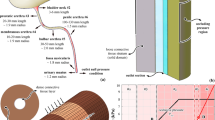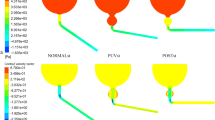Abstract
The aim of this study is to create a computational model of the human ureteral system that accurately replicates the peristaltic movement of the ureter for a variety of physiological and pathological functions. The objectives of this research are met using our in-house fluid-structural dynamics code (CgLes–Y code). A realistic peristaltic motion of the ureter is modelled using a novel piecewise linear force model. The urodynamic responses are investigated under two conditions of a healthy and a depressed contraction force. A ureteral pressure during the contraction shows a very good agreement with corresponding clinical data. The results also show a dependency of the wall shear stresses on the contraction velocity and it confirms the presence of a high shear stress at the proximal part of the ureter. Additionally, it is shown that an inefficient lumen contraction can increase the possibility of a continuous reflux during the propagation of peristalsis.











Similar content being viewed by others
References
Wein AJ, Kavoussi L, Partin W, Peters CA. Urology, Campbell-Walsh. Vol. 2 of section XIV. 2012.
Weiss RM, Wagner ML, Hoffman BF. Localization of the pacemaker for peristalsis in the intact canine ureter. Invest Urol. 1967;5(42):1.
Osman F, et al. A novel videomicroscopic technique for studying rat ureteral peristalsis in vivo. World J Urol. 2009;27(2):265–70.
Yin FC, Fung YC. Mechanical properties of isolated mammalian ureteral segments. Am J Physiol Leg Content. 1971;221(5):1484–93.
Watanabe H, Nakagawa Y, Uchida M. Tests to evaluate the mechanical properties of the ureter. In: Kambic HE, Yokobori AT, editors. Biomaterials’ mechanical properties. ASTM International; 1994.
Sokolis DP, et al. Age- and region-related changes in the biomechanical properties and composition of the human ureter. J Biomech. 2017;51:57–64.
Eken Alper, Akbas Tugana, Arpaci Taner. Spontaneous rupture of the ureter. Singap Med J. 2015;56(2):e29.
Choi S-K, et al. A rare case of upper ureter rupture: ureteral perforation caused by urinary retention. Korean J Urol. 2012;53(2):131–3.
Woodside JR, Borden TA. The pressure-flow relationship of the normal ureter. Invest Urol. 1980;18(1):82–3.
Shafik Ahmed. Ureteric profilometry: a study of the ureteric pressure profile in the normal and pathologic ureter. Scand J Urol Nephrol. 1998;32(1):14–9.
Irina M, Lubov K. Ureteric function and upper urinary tract urodynamics in patients with stones in kidney and ureter. In: Kommu SS, editor. Evolving trends in urology. InTech; 2012.
Tillig Bernd, Constantinou Christos E. Videomicroscopic imaging of ureteral peristaltic function in rats during cystometry. J Pharmacol Toxicol Methods. 1996;35(4):191–202.
Lewis CA, et al. Radionuclide imaging of ureteric peristalsis. BJU Int. 1989;63(2):144–8.
Patel U, Kellett MJ. Ureteric drainage and peristalsis after stenting studied using colour Doppler ultrasound. BJU Int. 1996;77(4):530–5.
Roshani H, et al. An in vivo endoluminal ultrasonographic study of peristaltic activity in the distal porcine ureter. J Urol. 2000;163(2):602–6.
Venkatesh R, et al. Impact of a double-pigtail stent on ureteral peristalsis in the porcine model: initial studies using a novel implantable magnetic sensor. J Endourol. 2005;19(2):170–6.
Roshani H, et al. A study of ureteric peristalsis using a single catheter to record EMG, impedance, and pressure changes. Tech Urol. 1999;5(1):61–6.
Ulmsten Ulf, Diehl Jan. Investigation of ureteric function with simultaneous intraureteric pressure recordings and ureteropyelography. Radiology. 1975;117(2):283–9.
Young AJ, et al. Evaluation of novel technique for studying ureteral function in vivo. J Endourol. 2007;21(1):94–9.
Kiil Fredrik. Function of the ureter and renal pelvis. Ann Surg. 1958;148(2):280–91.
Manton MJ. Long-wavelength peristaltic pumping at low Reynolds number. J Fluid Mech. 1975;68(3):467–76.
Zien T-F, Ostrach S. A long wave approximation to peristaltic motion. J Biomech. 1970;3(1):63–75.
Vahidi B, Fatouraee N. A numerical simulation of peristaltic motion in the ureter using fluid structure interactions. In: Engineering in medicine and biology society, 2007. EMBS 2007. 29th annual international conference of the IEEE. IEEE; 2007.
Xiao Q, Damodaran M. A numerical investigation of peristaltic waves in circular tubes. Int J Comput Fluid Dyn. 2002;16(3):201–16.
Kumar BVR, Naidu KB. A numerical study of peristaltic flows. Comput Fluids. 1995;24(2):161–76.
Vahidi B, et al. A mathematical simulation of the ureter: effects of the model parameters on ureteral pressure/flow relations. J Biomech Eng. 2011;133(3):031004.
Vahidi B, et al. A mathematical simulation of the ureter: effects of the model parameters on ureteral pressure/flow relations. J Biomech Eng. 2011;133(3):031004.
Woodburne Russell T, Lapides Jack. The ureteral lumen during peristalsis. Dev Dyn. 1972;133(3):255–8.
Hosseini G, et al. Computational simulation of the urinary system. In: Proceedings of the world congress on engineering and computer science, Vol II; 2012. ISBN: 978-988-19252-4-4.
Hosseini G, et al. Simulation of the upper urinary system. Crit Rev™ Biomed Eng. 2013;41(3):259–68.
Thomas TG, Williams JJR. Development of a parallel code to simulate skewed flow over a bluff body. J Wind Eng Ind Aerodyn. 1997;67:155–67.
Ji C, Munjiza A, Williams JJR. A novel iterative direct-forcing immersed boundary method and its finite volume applications. J Comput Phys. 2012;231(4):1797–821.
Munjiza AA. The combined finite-discrete element method. New York: Wiley; 2004.
Singh KM, et al. On parallel pre-conditioners for pressure Poisson equation in LES of complex geometry flows. Int J Numer Meth Fluids. 2017;83(5):446–64.
Boyarsky S, Gottschalk CW, Tanagho EA. Urodynamics: hydrodynamics of the ureter and renal pelvis. London: Academic Press; 2014.
Davenport K, Timoney AG, Keeley Jr. FX. The role of ureteral relaxation in the promotion of stone passage. In: AIP conference proceedings, Vol. 900. No. 1. AIP; 2007.
Arlen AM, Kirsch AJ, Leong T, Cooper CS. Validation of the ureteral diameter ratio for predicting early spontaneous resolution of primary vesicoureteral reflux. J Pediatr Urol. 2017. https://doi.org/10.1016/j.jpurol.2017.01.012.
Acknowledgements
National computing time was provided by UK Turbulence Consortium under EPSRC Grant EP/L000261, Clinical data was provided by Urology Research Innovation at Whipps Cross Hospital.
Author information
Authors and Affiliations
Corresponding author
Ethics declarations
Conflict of interest
None.
Ethical approval
All scans showing the whole ureter with normal anatomy were anonymised and chosen at random from a larger educational set.
Rights and permissions
About this article
Cite this article
Hosseini, G., Ji, C., Xu, D. et al. A computational model of ureteral peristalsis and an investigation into ureteral reflux. Biomed. Eng. Lett. 8, 117–125 (2018). https://doi.org/10.1007/s13534-017-0053-0
Received:
Revised:
Accepted:
Published:
Issue Date:
DOI: https://doi.org/10.1007/s13534-017-0053-0




